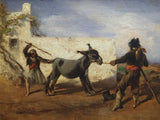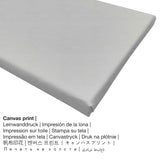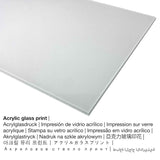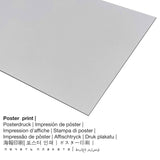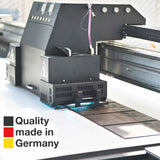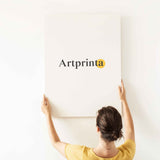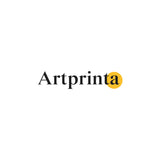Антон Ромако, 1856 - Тврдоглави магарац - графика
Порез укључен. Испорука обрачуната на каси.
модерна уметност артпиеце The stubborn donkey was made by the historicist artist Антон Ромако. The original version measures the size 26 x 34 cm - frame dimensions: 33 x 47 x 6 cm. Уље на платну was applied by the European artist as the technique for the piece of art. Today, the artpiece forms part of the digital art collection of Belvedere in Vienna, Austria. This public domain masterpiece is included, courtesy of © Белведере, Беч, пописни број: 1959. : dedication Hermione Eissler, Vienna in 1918. Штавише, поравнање дигиталне репродукције је пејзаж и има однос 4 : 3, which means that the length is 33% longer than the width. The painter Anton Romako was an artist from Austria, whose artistic style can primarily be classified as Historicism. The artist was born in the year 1832 у Бечу, држава Беч, Аустрија и умро у 57. години 1889.
Изаберите свој омиљени материјал предмета
За сваки производ нудимо низ различитих материјала и величина. Изаберите сада једну од следећих опција производа како бисте одговарали вашим жељама у величини и материјалу:
- Платно: A UV printed canvas material mounted on a wood frame. The advantage of canvas prints is that they are relatively low in weight, which means that it is easy and straightforward to hang up your Canvas print without extra wall-mounts. A canvas print is suited for any kind of wall.
- Постер (материјал на платну): The poster is a printed sheet of canvas with a nice texture on the surface. It is particularly suited for placing your art replica with the help of a custom-made frame. Please bear in mind, that depending on the absolute size of the canvas poster print we add a white margin 2-6cm around the print motif to facilitate the framing with a custom frame.
- Метал (алуминијумски двобојни отисак): Aluminium Dibond prints are prints on metal with a true depth effect. The Aluminium Dibond Print is the perfect start to replicas with aluminum. The white & bright sections of the original artpiece shine with a silk gloss but without any glare.
- Штампа од акрилног стакла (са правим премазом од стакла на врху): A glossy print on acrylic glass, which is often labelled as a an art print on plexiglass, will turn your favorite original into décor. Beyond that, it is a viable alternative to aluminium and canvas art prints. With an acrylic glass fine art print contrasts and details become recognizeable thanks to the very fine tonal gradation of the print.
Important legal note: We try what we can in order to describe the art products as exact as possible and to exhibit them visually on the product detail pages. At the same time, the pigments of the printing material and the printing might differ slightly from the presentation on your screen. Depending on the screen settings and the quality of the surface, not all colors are printed 100% realistically. Because the fine art prints are processed and printed by hand, there may also be minor discrepancies in the exact position and the size of the motif.
Структурирани детаљи о производу
| Чланка категоризација: | зидна уметност |
| Репродукција: | дигитална репродукција |
| Начин производње: | дигитална штампа |
| Порекло производа: | произведено у Немачкој |
| Врста залиха: | на захтев |
| Намена производа: | зидна уметност, дизајн куће |
| Оријентација слике: | пејзажни формат |
| Однос слике: | 4 : 3 дужине до ширине |
| Импликација односа пропорција: | дужина је за 33% дужа од ширине |
| Доступни материјали производа: | отисци на платну, метални отисак (алуминијумски дибонд), отисак акрилног стакла (са правим стакленим премазом), отисак плаката (платнени папир) |
| Опције величине платна на раму носила (штампа на платну): | 40к30цм - 16к12 ", 80к60цм - 31к24", 120к90цм - 47к35 ", 160к120цм - 63к47" |
| Штампа од акрилног стакла (са правим стакленим премазом): | 40к30цм - 16к12 ", 80к60цм - 31к24", 120к90цм - 47к35 " |
| Варијанте плаката (папир на платну): | 40к30цм - 16к12 ", 80к60цм - 31к24", 120к90цм - 47к35 " |
| Величине алуминијумског двобоја: | 40к30цм - 16к12 ", 80к60цм - 31к24", 120к90цм - 47к35 " |
| Рам: | Без оквира |
Структурисана табела уметничког дела
| Наслов уметничког дела: | "The stubborn donkey" |
| Категоризација уметничког дела: | слика |
| Кровни термин: | модерна уметност |
| Временска класификација: | КСНУМКСтх век |
| Настало године: | 1856 |
| Старост уметничког дела: | преко КСНУМКС година |
| Медијум оригиналних уметничких дела: | уље на платну |
| Величина оригиналног уметничког дела: | 26 к 34 цм - димензије оквира: 33 к 47 к 6 цм |
| Музеј / колекција: | Белведере |
| Локација музеја: | Беч, Аустрија |
| Веб локација музеја: | ввв.белведере.ат |
| Лиценца: | Јавни домен |
| Љубазношћу: | © Белведере, Беч, пописни број: 1959 |
| Кредитна линија уметничких дела: | dedication Hermione Eissler, Vienna in 1918 |
Кратак преглед уметника
| Име извођача: | Антон Ромако |
| Такође познат као: | romako a., a. romako, romako anton, Romako, Romako Anton, Anton Romako |
| Пол уметника: | мушки |
| Националност уметника: | Аустријски |
| Послови извођача: | сликар |
| Земља уметника: | Аустрија |
| Категорија извођача: | савремени уметник |
| Ликовни стилови: | Историка |
| Животни век: | КСНУМКС година |
| Година рођења: | 1832 |
| Место рођења: | Беч, држава Беч, Аустрија |
| Година смрти: | 1889 |
| Место смрти: | Беч, држава Беч, Аустрија |
Цопиригхт © - Artprinta (www.artprinta.com)
Оригинални опис уметничког дела са веб странице Белведере (© - Белведере - Белведере)
The oil painting The stubborn donkey Anton Romako was probably in 1856 during a trip to Spain by the artist and is considered the earliest surviving genre painting in his oeuvre. The contrast, saturated colors of humorous scene corresponds to the intense light of the South. The loose and sketchy brushwork acting like about works by Francisco de Goya or El Greco remember and is probably due Romako encounter with original works of Spanish painting tradition. 1860 gained Romako in Rome primarily oriented on the art market landscape views, genre paintings and portraits large financial and social recognition. After a failed marriage to the artist in 1875 returned to Vienna, where his style but not met the prevailing taste. With his increasingly bizarre and excessive design language and the emphasis on psychological moments he took elements of early expressionism anticipated. lonely in his later years and impoverished, was Romako an outsider among the historicist painters that should be rediscovered by future generations as an important reference point. [Kerstin Krenn, in: Agnes Husslein, Severin Dünser, Luisa Ziaja (ed.), Flirting with Strangers. Encounters with works from the collection, Vienna 2015, p 106.]

